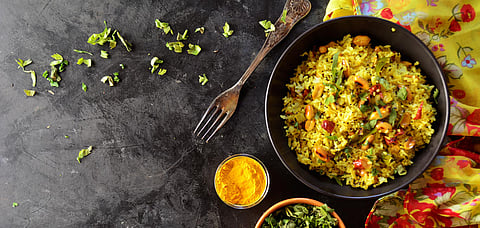
- Destinations
- Experiences
- Stay
- What's new
- Celebrating People
- Responsible Tourism
- CampaignsCampaigns
- SubscribeSubscribe
- Buy Now

As John Green first said it, I fell in love the way you fall asleep slowly, and then all at once. It was 9 am on a Monday morning. The metallic sound of the spoon clang on the pot with a tone of finality, while a familiar smell of accidentally-on-purpose burnt onion rings was rising in a crescendo in the air. Before I could spend any further time identifying these symphonic elements, my reverie was broken. A fellow heap of yellow rice, I thought, was spooned into my plate, smelling strongly of lemon and shallow-fried peanuts. A deeper investigation and probing with my spoon proved that it was in fact, poha, the flattened rice dish which is a staple in Maharashtra.
Having grown up in North India, I was skeptical of the poha being the main event of my breakfast. Now don&rsquot get me wrong&mdashI had had the poha many times, of course. It was an inevitable member of the breakfast in my household, wedged between the casserole of paranthas and sandwiches. I never saw the appeal in it, however. How could I, when it was always stuffed with cooked peas and carrots, tasting as though something was&mdashfor lack of a better word&mdashamiss
I set aside my qualms, and let hunger lead my actions, digging my spoon into the soft starchy hill on my plate. I was surprised. The poha was soft but not mushy spicy yet sweet, with a balanced crunch of caramelised onions and hit of green chillies. This was my first introduction to the kandha (onion) poha of Maharashtra.
I wasn&rsquot the only convert in my family. My mother, when she came visiting, was bowled over by the dish. In her world in Delhi, the same dish prepared was made of a thicker rice, rendering it tasteless, much too flavourless, something she&rsquod avoid in favour of its stronger siblings&mdashupma and seviya.
Here in Mumbai, however, my cook, Kanta bai changed our worldview on this rice dish. She was a master of the art of multi-tasking. Some would say that she probably invented the term, although in Marathi. Ten things were going on at once in the kitchen, and her culinary instincts knew just when to lower the heat on a boiling pan, when to deftly throw in garlic at the right timing, and how many whistles to set to the pressure cooker. For a cook of that calibre, what was a simple poha
I began asking her to make me poha almost every day, and she&rsquod flourish it on the table in less than 8 minutes, each time consistently good. And so my habit of nourishing myself on corn, cheese toasts and idlis were replaced by poha.
It wasn&rsquot just me, it turned out&mdashthe whole of Maharashtra was in on this not-so-underground community of poha-lovers. Street corners and the outside of railway stations are bursting with small stalls as willing you give you a vada pav as to serve you some poha, along with some cutting chai. Restaurants too would have an incomplete menu if they didn&rsquot mention poha on it&mdashso the more luxurious Bombay Coffee House in Bandra or delivery-driven Chai pe Charcha also offer the dish. Once after a trek to Kaas Plateau, Maharashtra&rsquos valley of flowers, I was with a group and we were all hungry and in need of sustenance. We stopped by a small vendor to ask for tea and were surprised to be some really delicious poha as well. Even in a small, cold corner of the state, we found ourselves a plate of comfort.
Taking the label 'breakfast food' to another extreme, there are a few shops in Mumbai that open up at 3 am to just serve poha. Needless to say, these are sold out by 6am. In recent years, the humble poha has also been advocated as a health food, suddenly brought to the limelight along with sabja seeds and bajra. As a low-fat, high in fibre and low in calorie dish, it is increasingly recommended by dieticians and nutritionists in the country.
It&rsquos as popular in other states such as Rajasthan, Madhya Pradesh as in Maharashtra. In fact, in MP, it is such a staple that they&rsquore even using it as political tools with poha chaupars (conversations over poha) being held before elections earlier this year.
Meanwhile, in my life, like all great things, even Kanta bai had to go one day, as I shifted away from the area. But before she left, she very graciously shared the recipe with me Take a frying pan and heat a little cooking oil in it. Toss in some finely chopped green chillies, and peanuts and stir them in the oil. Add thin slices of onion and let them cook. Add equal amounts of sugar and salt to it to caramelise it faster. On the side, soak a little poha with water on the side (not too much to make it soggy) and now add to your pan. Mix well while adding more water, haldi and salt, and a sprinkle of coriander. Squeeze a little lemon on top and voila
A couple of years later, I&rsquom back in Delhi and have a startlingly low repertoire of things I can claim to cook. They are, in increasing level of skill charred toast, the fried egg, and Maharashtrian poha. Naturally, when people come over, I do anything to show off my poha-making prowess and whip up bowls of the delicacy, with only a rhetorical question to ask Who wants some poha
